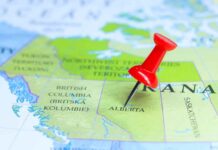EDMONTON – The first-quarter report for 2020-21 forecasts Alberta’s deficit at $24.2 billion after the devastating economic impacts of the COVID-19 pandemic and oil price crash.
The 2019-20 Annual Report and 2020-21 First Quarter Fiscal Update and Economic Statement show the toll both challenges have taken on the province. The province now sits on a debt burden of $99.6 billion, or $22,400 per Albertan. All the while Albertans have experienced losses of more than 170,000 jobs and a 13 percent unemployment rate.
The first-quarter projections show a significant increase to the deficit reaching $24.2 billion – $16.8 billion higher than estimated in Budget 2020. Almost 70 percent of this increase is due to a sharp decline in revenue with non-renewable resource revenue down $3.9 billion. Total revenue is estimated to be $38.4 billion, down $11.5 billion, or 23 percent from Budget 2020.
“These numbers are incredibly sobering to all of us. If left unchecked, they predict a grim reality for Albertans. We are facing the most significant economic challenge of our generation. To deal with this challenge, our government is developing a path forward – a path of economic recovery that will see job creation, diversification, and stability restored to Alberta’s finances,” states Travis Toews, President of Treasury Board and Minister of Finance.
The total expense is forecast at $62.6 billion. The government responded to the COVID-19 pandemic with extensive public health supports and relief measures for Albertans, Alberta businesses, and municipalities. These one-time spending measures, along with investments in Alberta’s Recovery Plan to position the province for economic growth, were necessary to see the province through these unprecedented times.
An updated economic forecast shows the pandemic has negatively affected business investment, oil production and consumer spending. Although 2020 began with a strong investment market, the fallout of COVID-19 has sidelined that expected growth. Alberta’s economy is expected to contract by 8.8 percent in 2020, the largest decline in modern-day history and a decrease of 11.3 percentage points from the budget forecast.
Alberta’s Recovery Plan builds on the initial actions we were taking to rebuild our economy before the pandemic hit. This included bringing in the Job Creation Tax Cut, eliminating the job-killing carbon tax and cutting red tape. Alberta’s government will continue moving forward by investing in infrastructure projects that put Albertans back to work, supporting growth in key sectors and positioning the province for future economic prosperity.
Quick facts – First Quarter Fiscal Update
- The deficit is forecast at $24.2 billion for 2020-21
- Taxpayer-supported debt is forecast to be $99.6 billion on March 31, 2021
- Total forecasted revenue is $38.4 billion which is down $11.5 billion from budget
- Total forecasted expense is $62.6 billion, which is an increase of $5.3 billion from budget
- $1.4 billion has been added to the 2020-21 Capital Plan, with total capital plan spending for the year now at $8.4 billion. The majority of these increases reflect economic stimulus and support for municipalities as part of Alberta’s Recovery Plan
- As part of the recovery plan, government added a $1.5 billion commitment to the Keystone XL pipeline, bringing Alberta’s total commitment to infrastructure in 2020-21 to nearly $10 billion
Quick facts – Annual Report
- The key results in the annual report reflect the 2019-20 fiscal year ending March 31, 2020
- The deficit in 2019-20 was $12.2 billion
- Total revenue was $46.2 billion, $3.7 billion lower than budgeted and $3.3 billion lower than in 2018-19
- Total expense is almost $300 million lower than Budget 2019






